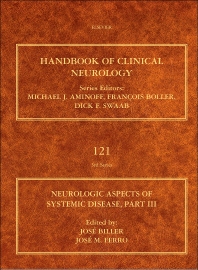Books in Neuroscience
Elsevier's Neuroscience collection empowers educators, researchers, and students with actionable knowledge to drive collaborative research and advancements in the field. Content covers the nervous system's intricate workings, covering branches like Affective, Behavioral, and Cognitive neuroscience to investigate the neural basis of emotions, behavior, and cognitive functions. Spanning from Molecular and Cellular Neuroscience to Developmental Neuroscience, content provides insights into brain function in health and disease.
- 1st Edition
- Volume 122
- February 5, 2014
- Douglas S. Goodin
- English
- Hardback9 7 8 0 4 4 4 5 2 0 0 1 2
- eBook9 7 8 0 4 4 4 6 3 3 0 9 5

Multiple Sclerosis and Related Disorders
- 1st Edition
- January 27, 2014
- Peter Morris
- English
- Hardback9 7 8 0 8 5 7 0 9 1 2 7 7
- Paperback9 7 8 0 0 8 1 0 1 5 1 9 3
- eBook9 7 8 0 8 5 7 0 9 7 4 7 7

Biomedical Imaging
- 1st Edition
- January 22, 2014
- Asim Kumar Roy Choudhury
- English
- Hardback9 7 8 0 8 5 7 0 9 2 2 9 8
- Paperback9 7 8 0 0 8 1 0 1 3 9 1 5
- eBook9 7 8 0 8 5 7 0 9 9 2 4 2

Principles of Colour and Appearance Measurement
- 1st Edition
- January 16, 2014
- Julien Cohen-Adad + 1 more
- English
- Hardback9 7 8 0 1 2 3 9 6 9 7 3 6
- eBook9 7 8 0 1 2 3 9 7 2 8 2 8

Quantitative MRI of the Spinal Cord
- 1st Edition
- Volume 121
- January 9, 2014
- Jose Biller + 1 more
- English
- Hardback9 7 8 0 7 0 2 0 4 0 8 8 7
- eBook9 7 8 0 7 0 2 0 4 4 3 4 2

Neurologic Aspects of Systemic Disease, Part III
- 1st Edition
- December 26, 2013
- Carl Faingold + 1 more
- English
- Hardback9 7 8 0 1 2 4 1 5 8 0 4 7
- eBook9 7 8 0 1 2 4 1 5 8 6 4 1

Neuronal Networks in Brain Function, CNS Disorders, and Therapeutics
- 1st Edition
- December 21, 2013
- Mary B. Howes + 1 more
- English
- Hardback9 7 8 0 1 2 4 0 8 0 8 7 4
- eBook9 7 8 0 1 2 4 0 8 1 0 6 2

Human Memory
- 1st Edition
- Volume 60
- December 18, 2013
- English
- eBook9 7 8 0 1 2 8 0 0 3 9 1 6

Psychology of Learning and Motivation
- 1st Edition
- Volume 206
- December 11, 2013
- English
- Hardback9 7 8 0 4 4 4 6 3 3 6 4 4
- eBook9 7 8 0 4 4 4 6 3 3 8 7 3

Literature, Neurology, and Neuroscience: Neurological and Psychiatric Disorders
- 1st Edition
- December 5, 2013
- Lee E. Eiden
- English
- Paperback9 7 8 0 1 2 8 0 0 0 4 4 1
- eBook9 7 8 0 1 2 8 0 0 0 7 3 1

Catecholamine Research in the 21st Century
Related subjects
Behavioral neuroscience
Cognitive neuroscience
Developmental neuroscience and regeneration
Molecular neuroscience
Neural aging
Neuroanatomy
Neurobiology
Neurochemistry
Neuroendocrinology
Neurogenetics
Neuroimmunology
Neurology
Neuropathology
Neuropharmacology
Neurophysiology
Neuroscience general
Neuroscience methodology
Neurotoxicology
Sensory systems